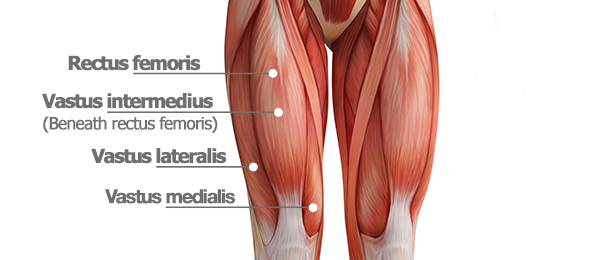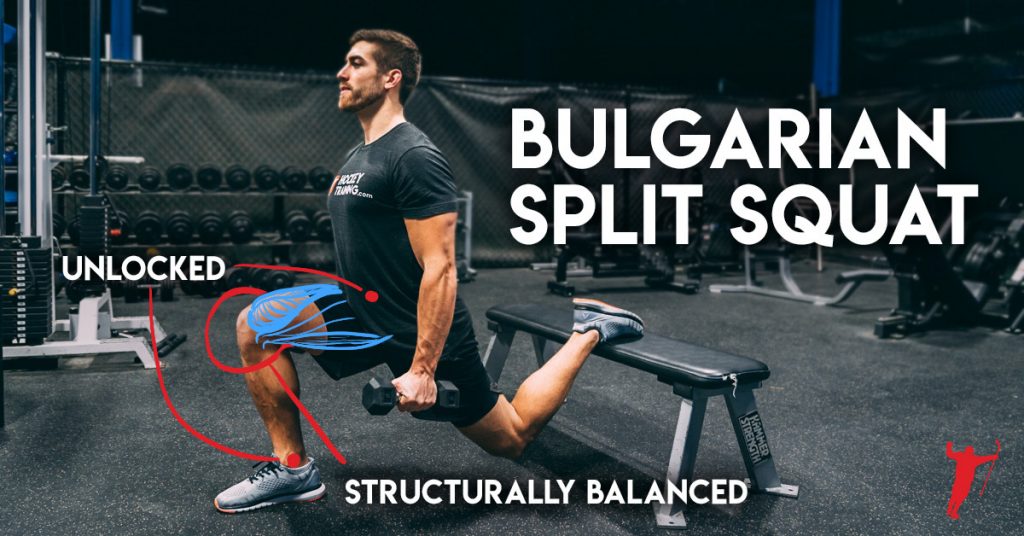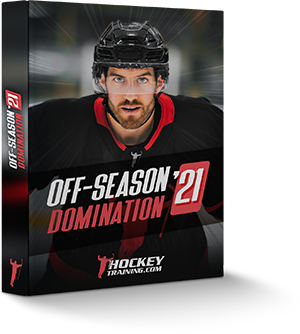In this article, I will break down the #1 best hockey exercise that hockey players should perform for the most well-rounded hockey-specific benefits.
Of course, the “best exercise” can be very context-specific based on your individual needs, health, abilities, and limitations. But rather than bore you with an endless list of “it depends” sections, I’ve decided to solely focus on the exercise with the most well-rounded benefits for hockey players—assuming that you’re healthy and uninjured and don’t have any glaring weaknesses.
To put it simply, this exercise wins the “bang for the buck” contest, assuming all things are equal in your development.
Now that we have that caveat out of the way, I would like to introduce you to the #1 secret weapon to developing hockey players faster than ever: The Bulgarian Split Squat.
The Bulgarian Split Squat
The Bulgarian Split Squat has become a primary lower body exercise selection I choose when working with hockey players because of its hockey-specific muscle stimulation.
Despite popular belief from “hardcore” coaches, you can’t just slam your athletes nonstop with back squats, front squats, and deadlifts and expect them to become better hockey players because of it.
Don’t get me wrong: those movements are excellent movements, and I program them accordingly in my systems.
But due to the stress on the spine and massive neural recovery-debt, I’ve found they can offset performance in the equally important specific physical preparedness (SPP) work in your agility, aerobic conditioning, anaerobic conditioning, speed development, and skill acquisition training.
Major compound movements aren’t the only way to get incredibly strong and maximally functional legs. Plus, you can do the Bulgarian Split Squat without loading your spine several days per week (and thus creating repetitive fatigue-debt that leaks into your other training days).
Before you slap a wimp tag on me and search for your next “no pain, no gain” back squat article, hear me out, because I think we can come to a very logical agreement toward the end of this article.
A Young Coach Garner at Gold’s Gym
In 2011, I began my career as a personal trainer at a Gold’s Gym in London, Ontario, Canada.
During this time, I dabbled a bit in the world of Bulgarian Split Squats, but never really thought of them as a strength exercise because they weren’t one of the familiar compound movements I saw everyone doing.
One day I had a lightbulb moment and asked myself, “Why do I keep using this exercise only as a bodyweight ‘burnout’ movement for my athletes? There is no reason not to add significant load to this movement…let’s guinea pig this on some athletes and see what happens.”
Shortly thereafter, this movement became a staple in my programming, and I haven’t looked back since.
My experiences with this movement have far surpassed my expectations, and even with all the new equipment that has been invented since that time, I still haven’t found anything as effective or well-rounded as the Bulgarian Split Squat for getting hockey players killer results.
My hockey players don’t experience back pain, their strength and hypertrophy results are awesome, and they are way faster skaters for keeping it in their programming.
The biggest “problem” now that I have with my elite players is that they max out the dumbbells at the gym they train at, so they have to add things such as weighted vests, chains, and whatever else they can find to keep the training stimulus high.
My fascination with the movement initially began with how injury-proof my hockey players became. Hip pain, groin pulls, hamstring strains, and knee injuries all substantially disappeared even at the highest possible level of performance.
Occasionally, you get a hockey player who feels a little knee pain during the movement, but that’s easily remedied by moving the front foot further away from the bench that their back foot is on. Some players might report that their rear leg has a weird pull on the groin/hip flexor area during the exercise, but this is easily rectified by lowering the height of the bench that their back foot is on.
Once they find that pain-free sweet spot of exercise execution, it’s away to the races.
Working in-person as a personal trainer, I also found it remarkably user-friendly in that people could perform this exercise well, very quickly. This is important to care about because many lifters struggle for years learning how to squat correctly (and honestly, some people never learn).
Walk inside any commercial gym and you will see way more terrible squats than you will see good ones. Usually this is due to bad technique, poor mobility, inadequate stability—and an over-inflated ego. Naturally, this leads to injuries and pain pretty quick, but people keep doing it because bad coaches tell them they “have to” to get results.
However, the Bulgarian split squat is super easy to teach and perform. Not to mention, it removes the dumb ego people have about loading weight on a bar.
So, with less load and better technical execution, you get a movement that’s a much better option overall for both results and training longevity.
Finally, there are those who just aren’t meant to squat very well. Maybe it’s due to a former injury, or maybe it’s due to the way they’re built. Many hockey players with long femurs and long torsos will turn their squats into good mornings, transferring much of the force from the legs to the lower back, which is both dangerous and ineffective for enhancing hockey performance.
Practice and coaching may improve their technique slightly, but for the most part it will be an uphill battle.
My question for these people is, “Since you aren’t training for powerlifting, why are you forcing yourself to back squat even though you’re not built for it?”
You’re here to become a better hockey player, not a better squatter. Give that some thought and understand that people in the gym who give you absolute statements regarding training methods likely don’t have your best interest in mind.
The Bulgarian Split Squat Has No Ceiling
If you’re back squatting, a major limiting factor is your lower back. If you’re front squatting, a major limiting factor is your upper back.
With the Bulgarian Split Squat, you effectively get rid of those limitations and are able to create a much stronger mind-muscle connection and training stimulus for your lower body.
Furthermore, because you’re not loading the spine as heavily, it doesn’t take nearly as long to recover from, which means you can perform them with greater training frequency during a general physical preparedness (GPP) phase, or leave much more recovery capacity for your speed/agility/conditioning work during an SPP phase.
I already know what you’re thinking: you think that stability would be a major limiting factor in getting strong during this movement.
But this just isn’t the case for the Bulgarian Split Squat, which makes it the #1 functional lower body strength training exercise in the game.
In many ways, it marries bilateral and unilateral lower body movements, because you’re getting the benefits of single leg training but still getting the stability assistance you need from the rear leg to use heavy loads.
That back leg isn’t doing much as far as lifting the weight, but it works wonders for providing stability so you can work your front leg harder.
The ceiling isn’t nearly as low as most people think it is with this movement. You can load it with heavy weights very safely and securely.
“You Can’t Gain Size Without Squats!”
Yes, yes you can.
Utilizing more Bulgarian Split Squats doesn’t mean you’re going to have chicken legs out on the ice. Just ask the thousands of hockey players who have done my programming and they’ll tell you the same thing.
In fact, you might actually gain more size in your lower body by doing Bulgarian Split Squats instead.
Don’t believe me? Consider this: the front leg is handling about 80% of the load when performing Bulgarian Split Squats (although this is impossible to substantiate from one individual to the next, I’d say that’s a fair estimate).
Now consider that a major percentage of hockey players I work with use the same weight for Bulgarian Split Squats as they do for barbell front squats.
Meaning, if you do sets of front squats at 185lbs for 5 reps, you’ll likely be doing sets of Bulgarian Split Squats at 185lbs for 5 per leg on the Bulgarian Split Squat.
If you’re really built for strong squats (i.e. you’re stocky, have short femurs and great squat mechanics, etc.) then you will at best front squat 10% more than you will Bulgarian Split Squat. This means if you Bulgarian Split Squat 185lbs x 5 per leg, you would front squat 205lbs for sets of 5.
If we assume 80% of the load is on your working leg during a Bulgarian Split Squat but equally distributed during a front squat (50% per leg), this means you are using a very similar load on the Bulgarian Split Squat but getting a much stronger training stimulus because only one leg is doing most of the work.
The technical simplicity, equal weight distribution (i.e. the bar isn’t in front of you), and lack of back fatigue allows you to place a greater amount of neural drive and force in your lower body to get more bang for the buck out of every rep that you do.
For these reasons, the Bulgarian Split Squat is a fantastic option for hockey players in both the strength and hypertrophy department and is just as useful as any bilateral movement you can name.
Why Bulgarian Split Squats Are Functionally Specific for Hockey
Almost every hockey player who first signs on with me has an over-development in the vastus lateralis in comparison to their vastus medialis.
The vastus lateralis is that thick muscle on the outside of your thigh, whereas your vastus medialis is that tear-shaped muscle at the inside point just over your knee.

If you have been playing hockey and skating your whole life, odds are you have a big chunk of meat on the outside of your thigh, and a minimally sized teardrop muscle on the inside of your knee.
That vastus lateralis gets overdeveloped through many years of skating because it’s a prime mover in the lateral drive you use to push the ice away and propel yourself forward.
Correcting this structural imbalance is paramount to increasing your skating speed, explosiveness, and agility on the ice—but will also play a huge role in improving knee stability (as the vastus medialis is one of the prime knee stabilizers) which decreases the risk of injury to hockey players in the lower body drastically.
The Bulgarian Split Squat does an excellent job at correcting and balancing the development of the lower body. Moreover, it is also a unilateral exercise, which means that it corrects for strength differences between your right and left legs as well, making you a more structurally balanced athlete not just within the quadriceps but from one side of the body to the next.
Balanced development = balanced and fluid athletic movement.
The benefits of structural balance cannot be understated in terms of maximizing performance, minimizing injury risk, and supercharging energy economy and skating mechanics out on the ice.
However, Bulgarian Split Squat aren’t just a structural corrector: they also improve hockey-specific hip mobility problems.
If you look at a hockey player, they are bent over at the waist for pretty much the entire game—during a face-off, when taking a shot, when skating, and even when sitting on the bench.
This shortens and tightens the hip flexors, which can lead to a whole host of postural issues including pain in the hips during movement, tightness in the hips negatively affecting edge work mechanics, rounded shoulders, shoulder impingements, lower back lordosis, and a forward lean in the neck.
In addition to the above, chronic bending over at the waist causes the pelvis to rotate forward, creating the aforementioned low back lordosis but also negatively affecting the core muscles ability to fire properly.
Core strength is critical in transferring power from the lower body to the upper body. All power originates from the ground up, and if your core is not up to par, your ability to produce power (and therefore, your entire hockey performance capability) takes a negative hit.
Are you starting to understand how everything has a ripple effect to different facets of the game when hockey-specific structural issues aren’t properly addressed?
Not to worry: the Bulgarian Split Squat is here!
Because your rear foot is elevated, your hip musculature has to go through a greater range of motion during each rep, which really helps unlock a lot of the common tight-hip issues so many hockey players run into.
Beyond this, Bulgarian Split Squats strengthen the glutes and groin muscles to improve stride length/frequency while breaking up minor adhesions within the calf/Achilles tendon to improve your ankle mobility and edge work mechanics.
At this point, I don’t want to make it sound like I am anti-squatting. That’s not the case at all, and you will see different squatting variations used in my programming. However, it is undeniable how amazingly well-rounded the Bulgarian Split Squat is in terms of “bang for the buck” for hockey players attacking so many different strength, structural balance, hypertrophy, and mobility issues all at once.
Best Bulgarian Split Squat Variations
In the beginning, it’s important to perform the movement in a bodyweight-only fashion until you have mastered the technique and you’re ready to add more load.
You will need a large toolkit of different Bulgarian Split Squat variations in order to continually expose your body to a new training stimulus that forces it to adapt and become a better version of itself.
Below is a compilation of the Bulgarian Split Squat variations I use most in my program design here at Hockey Training.
Bodyweight Bulgarian Split Squats
DB Bulgarian Split Squats
BB Bulgarian Split Squats
DB Bulgarian 1+¼ Split Squats
Bodyweight Bulgarian 1+¼ Split Squats
Bulgarian Split Squat Reps With Isometric Hold
Bulgarian Split Squat Isometric Hold
Bulgarian Split Squat Jumps
Front Foot Elevated Bulgarian Split Squats
Transform Your Game
If you’re ready to start training smarter than ever before when it comes to your hockey performance, I can tell you right now that you can make your hockey dream a reality with our new 2021 Off-Season Training System that features the F.A.S.T. Training Principle as part of our all-new E2-Formula™.
The new 2021 Off-Season Training System is backed by the latest knowledge in sports performance and provides you with the necessary amount of training stimulus needed to improve your functional strength and explosiveness so you can step on the ice as a completely different player next season.
You don’t have to be a “natural talent” to level up your game and have the best season of your life this year—because you can get instant access to the exact on-ice and off-ice training you need to be doing this year during the in-season so you can train just like your favorite NHL player.
Sure, you could go through all the research studies I have read and slowly piece everything together and you’d probably do just fine.
But if you want to take all of the guesswork out of it and get access to a completely “done for you” high-level program to get the best possible results, then head over to our 2021 Off-Season Training System page, and let’s get started today.
Final Thoughts
In the beginning of this article, I promised to break down what I believe to be the best “bang for the buck” hockey training exercise in existence.
I hope I’ve done that in a sound, logical way that is completely free from any of the marketing nonsense you see on social media these days regarding so-called “hockey-specific” exercises that look more like a circus act than a representation of sports science.
Sure, the “best exercise” for a hockey player is individually context-specific for many reasons.
However, I am asked weekly during live Q&As: “What’s the best hockey exercise?”. And I believe, when all things are equal, that the Bulgarian Split Squat takes the #1 spot.
This is especially true when you consider that I didn’t even discuss the effective tempo and plyometric variants you could use for this exercise to make it just as great of a speed/conditioning exercise as it is a functional strength/hypertrophy/mobility exercise.
Don’t forget to check out the new 2021 Off-Season Training System if you want to perform this exercise, along with all of the other best hockey training exercises, to completely explode your hockey performance potential and take everything to the next level this year.




Loved the information. Detailed and extremely easy to understand. Appreciate all you do for us hockey players! HockeyTraining.com forever!
I don’t know if I’ve come across any coach who writes as well as you do. You convey information in a flowing, entertaining way without ever getting off topic. Just wanted to say thank you! Going to devour all of your other articles now 😊
This is a very useful article for me as a physical coach for hockeyplayers. I’ve used the bulgarian split squat a lot, and it’s nice to hear and read that this ia an exercise I can use even more. Thank you for a very good article.